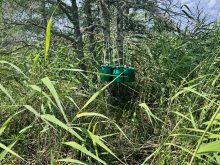Canada’s agriculture sector is on solid footing and well-positioned to withstand higher borrowing costs, according to Farm Credit Canada, the country’s largest agricultural lender.
But farmers who are heavily leveraged should pay close attention to rising interest rates and should have a good understanding of the financial risk that goes along with higher borrowing costs, adds J.P. Gervais, chief economist at FCC.
Growers who anticipate significant changes in their debt servicing obligations should talk with their lenders about potential strategies that could reduce the financial impact, such as longer amortization periods and early loan renewals.
Read Also

Research looks to control flea beetles with RNAi
A Vancouver agri-tech company wants to give canola growers another weapon in the never-ending battle against flea beetles.
“It all starts with understanding your financial risk,” Gervais said.
“Do you clearly understand the impact that a rate increase will have on your operation? It might be zero (impact) today if you’re locked in at a fixed rate. But six months from now, will it still be zero?
“And if it’s not, what kind of risk exposure will you have?
“That’s the critical thing for borrowers, is to understand what kind of exposure they will have over the next 12 to 18 months and to make decisions accordingly.”
On Sept. 7, the Bank of Canada increased its benchmark lending rate by 0.75 percent.
The 0.75 percent increase, which followed a one percent increase in July, has pushed the Bank of Canada rate to 3.25 percent and has prompted commercial lenders to increase their prime lending rates.
That means that many borrowers who negotiate new loans or renew existing ones will be facing interest rates that are 2.5 to three percent higher than they were 12 months ago.
In an interview, Gervais said rising interest rates will affect the Canadian agriculture industry and borrowers who make up FCC’s $44 billion lending portfolio. But the industry in general is in a strong position financially, he said.
Gross revenues for the Canada’s grain and oilseeds sector are projected to be 18 percent higher this year than they were 2021, according to current estimates.
Barring any significant or unforeseen negative changes in markets and commodity prices, most borrowers should be able to withstand higher interest rates.
But it’s imperative that borrowers understand their exposure and manage it.
FCC expects the Bank of Canada to hike rates by at least another 50 basis points between now and the end of the calendar year, and possibly more, Gervais said.
Sound, forward-looking financial management decisions that are made today will pay huge dividends in the next 12 months and beyond.
“Don’t wait,” Gervais said.
“I can’t emphasize this enough. Waiting is never a good strategy.
“I understand that farming operations are really busy right now… but the sooner you’re able to sit behind your desk, sharpen your pencil and work with your partners — your accountant or your financial adviser — the better.”
Gervais said FCC’s prime lending rate, which now sits at 5.45 percent, has gone up by 300 basis points, or three percent, in the last 12 months.
Loans that are coming up for renewal will have significant higher carrying costs, but those costs are expected to be even higher by the end of the year.
For some borrowers, early renewals might be worth a look. For others, longer amortization periods might provide relief.
FCC has seen an increasing tendency for more borrowers to opt for fixed rate terms.
In the fourth quarter of 2021, 62 percent of new loan disbursements were locked in at fixed rates.
By the first quarter of 2022, nearly 71 percent of new loan disbursements were fixed.
Despite the expectation that interest rates will rise further, Gervais said the Canadian agriculture sector remains in good shape overall.
“It’s going to costs us more in terms of interest expenses as an industry, but I do think we have the revenues to cover these expenses,” he said.
“Barring unforeseen unfavourable movement in commodity prices, I think the outlook remains positive.”


















